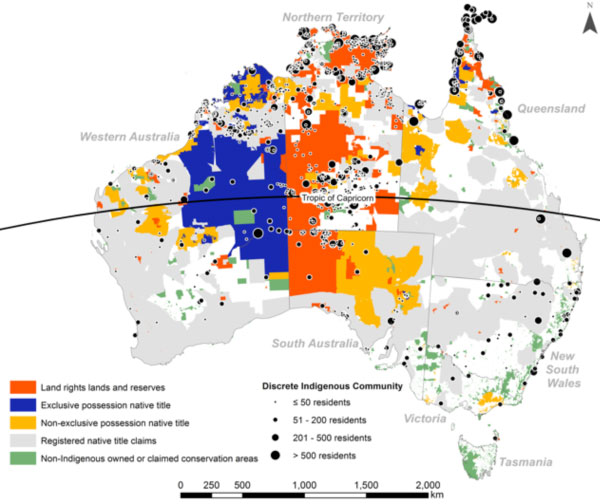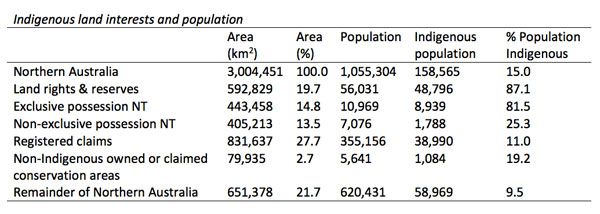In 2009 the Rudd government commissioned the Land and Water Taskforce chaired by Bunuba leader Joe Ross to examine the potential for sustainable development of Northern Australia. As a part of this process the Taskforce initiated the massive 1,100 page Land and Water Science Review managed by the CSIRO.
This review, in which (to be transparent, participated) drew on research from over 80 experts. It concluded, by synthesising the latest available biophysical science and social science, that there were severe constraints on northern development; any attempts to replicate development in temperate Australia in tropical Australia should proceed with extreme caution given risks of environmental degradation.
Challenging this review, in June 2013, the Coalition in opposition released its 2030 Vision for Developing Northern Australia highlighting that Australia’s geographic position provided significant growth opportunity for Northern Australia as a food bowl for Asia, as a tourist destination, and as the source of an energy export industry.
The Coalition committed to release a White Paper, Canberra-speak for a policy paper, on Northern Australia within 12 months of the 2013 Federal election. That deadline has passed and it is likely the White Paper will now be released in early 2015.
But in the meantime, a Joint Select Committee of the federal parliament has conducted an Inquiry into the Development of Northern Australia and released its final report Pivot North. Pivot is an interesting verb for the Committee to use, it means ‘to turn’ or ‘swing around’, presumably a reference to shifting national attention to the north as a region for new economic development.
This Report of over 200 pages attracted over 300 submissions and was completed in about eight months; it will be the major input to the development of the White Paper by a bureaucratic task force within the Department of Prime Minister and Cabinet in Canberra.
The Chairman of the parliamentary inquiry, Warren Entsch notes there have been numerous reports from Canberra about developing Northern Australia which are gathering dust on shelves, but none have come to much. This report will be different, it will prove the sceptics wrong, suggests Entsch, and it will get things moving.
Indeed it might if the Report’s 42 recommendations broken up into priority recommendations, recommendations addressing opportunities and development proposals (identified largely by particular interest groups in submissions and exhibits, in witness statements and special site visits) and remediating impediments. Implementing these recommendations will also cost Australian taxpayers billions of dollars in major infrastructure investments, although no costings are provided, and will take years to complete.
For a government that strongly espouses free market capitalism, the recommendations for developing the north look awfully like state capitalism, even heavier subsidy to extractive and service industries than is already occurring. And the billions that will need to be expended will obviously blow out the national budget bottom line that we are constantly reminded is in deep structural crisis, as Australia embraces an Era of Austerity. I suspect that Treasurer Hockey and Chairman Entsch might be at loggerheads about the billions needed to get things moving.
In early 2014 I was invited to provide a submission to the Select Committee Inquiry which I duly did with my colleague Francis Markham, an expert in Geographical Information Systems (GIS). Our main aim was to assist the Inquiry with factual information focused specifically on Indigenous interests, given that today Aboriginal people own much of the north under land rights and native title laws.
This is in marked contrast to 1947 when the first report for the Development of Northern Australia was completed and there was no Aboriginal land ownership according to settler colonial law.
Our submission no. 136 is publicly available here.
In it we sought to provide empirical information that divides Australia into Northern Australia and the rest of Australia, to conform to the Joint Select Committee’s terms of reference. We first looked at land ownership, population, and numbers and distribution of what are termed ‘discrete Indigenous communities’. Examples of the information we provided is shown in the following map and table.


The map shows that lands of confirmed Indigenous land rights and native title legal interest total 48 per cent of the 3 million square kilometres of Northern Australia. This area could expand to nearly 76 per cent if native title was determined to exist for the spatial entirety of all currently registered claims. Hence my question, whose Northern Australia?
Indigenous people are clearly the group with greatest land interest. And of the 1,187 discrete Indigenous communities in Australia, 73 per cent are in Northern Australia, with almost all located on or near Aboriginal-owned land. In areas where there is land rights and exclusive native title possession, the Aboriginal share of the population is over 80 per cent. Hence my other question, developing Northern Australia for whom?
In a series of other maps, we looked at the environmental condition of the land by using official resource atlas information on vegetation condition, threatened species and river disturbance. We showed that land in Northern Australia was in better environmental condition than land elsewhere in Australia and that areas of Indigenous land interest were least degraded of all.
We also looked at data on operating mines and known mineral deposits to show that there are relatively few mines currently operating on Indigenous land but there are some key mineral deposits located both on Indigenous lands and where there are registered native title claims. Accessing such deposits will require the consent of traditional owners or negotiation with native title parties.
And we showed how the high natural and cultural values of Indigenous lands have seen more and more incorporated into the national conservation estate; at the moment over half declared Indigenous Protected Areas, by area, are in Northern Australia, alongside iconic national parks like Kakadu and Uluru that are also under Aboriginal title.
I was surprised that none of this spatial and statistical information was referred to by the Inquiry.
Instead, it was disappointing to see the Inquiry made recommendations that largely reflected interest group lobbying. And while there was some reference to issues raised by submissions from organisations representing Aboriginal land owners, especially land councils, these were dealt with in a cursory manner given the extent of the Indigenous land interest in Northern Australia.
The Report though raised three broad issues that could adversely impact on Indigenous interests.
First, it is noted that at current rates of growth by 2050 more than half of the population of Northern Australia will be Indigenous (p.179). This population is identified on a number of occasions and very instrumentally as a potential source of untapped labour.
Simultaneously, the Report highlights that ways have to be found to significantly increase the population of Northern Australia presumably from interstate or overseas. This will dilute the one jurisdiction in Australia where the Indigenous share of the population is politically and demographically significant. There are some deep contradictions here.
Second, the Report identifies land rights and native title as impediments to developments, acknowledging that the simplifications of land tenure arrangements were mainly raised by non-Aboriginal interests. There is a specific recommendation (p.194) that calls for the ‘harmonisation and simplification of land tenure arrangements’.
At the same time the limited range of rights under native title tenure is identified as an impediment to the maximisation of economic development and employment opportunities on Aboriginal land. One suspects ‘harmonisation’ might actually mean dilution of the gold standard ‘free, prior and informed consent’ rights embedded in Northern Territory land rights law.
Third and most worrying, the Report imagines Northern Australia as some incomplete version of southern temperate Australia that needs urgent rectification, but in whose interest? A combination of rapid population growth from outside and land tenure ‘harmonisation’ might see a replication of the negative impact of colonial invasion on Indigenous societies in the south — many were nearly obliterated and are just now in the process of recovery. Surely, from an Indigenous perspective, this is not a model to replicate?
I end by returning to the five recommendations in our submission that were ignored by the Joint Select Committee, just like our spatial and statistical information. These are provided for readers to consider as a White Paper is developed for Black Northern Australia.
If Indigenous people are to equitably benefit from any development in Northern Australia, then their property rights in land and resources need to be strengthened and not weakened so that they can exercise ‘free, prior and informed consent’ to any proposals.
It is imperative that any development proposals for Northern Australia are ecologically sustainable so that the environmental damage wrought on temperate Australia in the quest for capitalist development is not repeated.
It is crucially important to engage properly with the available scientific evidence, especially the state of the art CSIRO Science Review and the latest climate science.
It is important to properly consider the relative costs and benefits of the provision of environmental services, extractive industries, commercial agriculture and tourism and to ask what are the comparative economic advantages of Indigenous lands and peoples?
It is critically important to consult properly and take proper account on a place-by-place basis of Indigenous aspirations and to realistically market test various possibilities.
It is politically expedient, but ultimately unconscionable, to just cherry pick Indigenous views that merely mirror dominant views about risky forms of capitalist development.
* A version of this article was published in Land Rights News Northern Edition October 2014/Edition 4.
Donate To New Matilda
New Matilda is a small, independent media outlet. We survive through reader contributions, and never losing a lawsuit. If you got something from this article, giving something back helps us to continue speaking truth to power. Every little bit counts.



